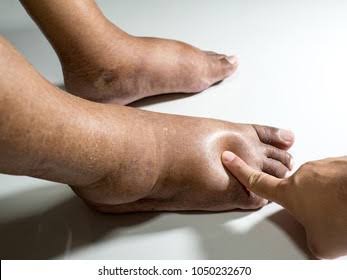
Injury, infection, heart failure, kidney disease, and other underlying health conditions can all cause swelling in the legs, feet and ankles….CONTINUE READING
Some causes of this swelling, such as standing or walking for long periods, are generally harmless. However, sudden or chronic swelling in the legs and ankles can indicate a health problem.
It is important to identify the underlying cause to determine the appropriate treatment. Here are some common causes of swollen legs and feet, along with ways to handle them:
1. Venous insufficiency: According to Healthline, This condition occurs when the veins in the legs have difficulty returning blood to the heart, resulting in swelling. To manage venous insufficiency, you can elevate your legs, exercise regularly, wear compression stockings, and avoid prolonged periods of standing or sitting.
2. Deep vein thrombosis (DVT): DVT is a blood clot that forms in a deep vein, commonly in the legs. It can cause swelling, pain, and redness. If you suspect DVT, seek immediate medical attention. Treatment may involve blood thinners and compression stockings.
3. Edema: Edema refers to the accumulation of fluid in the tissues, leading to swelling. It can be caused by factors such as prolonged standing or sitting, pregnancy, or certain medical conditions. To handle edema, you can try elevating your legs, wearing compression stockings, exercising regularly, and reducing your salt intake.
4. Lymphedema: Lymphedema is a condition where the lymphatic system is unable to drain fluid properly, leading to swelling. It can be caused by surgery, radiation therapy, or an underlying condition. Management includes compression therapy, manual lymphatic drainage, exercise, and skincare.
5. Infection: Infections, such as cellulitis, can cause localized swelling in the legs and feet. If you suspect an infection, consult a healthcare professional. Treatment may involve antibiotics and elevation of the affected area.
6. Kidney disease: Impaired kidney function can lead to fluid retention and swelling in the legs and feet. If you have kidney disease, work with your healthcare provider to manage your condition and follow their recommended treatment plan.
7. Heart failure: When the heart is unable to pump blood effectively, fluid can accumulate in the legs and feet. Treatment for heart failure includes medication, dietary changes, limiting salt intake, and managing underlying conditions.
8. Medications: Certain medications, such as calcium channel blockers or nonsteroidal anti-inflammatory drugs (NSAIDs), can cause leg and foot swelling as a side effect. If you suspect your medications are causing the swelling, consult your doctor to discuss alternative options.
9. Pregnancy: By the third trimester, your growing baby puts pressure on the veins in your legs. This slows the circulation of your blood and causes fluid to build up. The result: mild swelling.
If you notice these other symptoms as well, let your doctor know because it might mean you have a serious condition called preeclampsia.
10. Liver disease: The liver produces albumin, a protein that prevents fluid from leaking out of blood vessels and into surrounding tissues. A diseased liver does not produce enough albumin. As a result, fluid can pool in the legs, ankles, and feet.
Most people with liver disease have no symptoms until severe liver damage or cirrhosis develops.
The only cure for chronic cirrhosis is a liver transplant. But with other approaches, doctors aim to manage the disease, relieve any symptoms, and prevent complications.
It’s important to consult a healthcare professional for a proper diagnosis and personalized treatment plan if you experience persistent or severe swelling in your legs and feet….CONTINUE READING